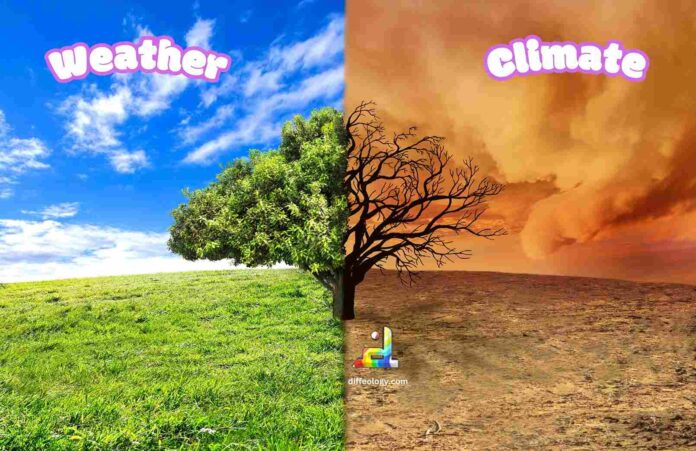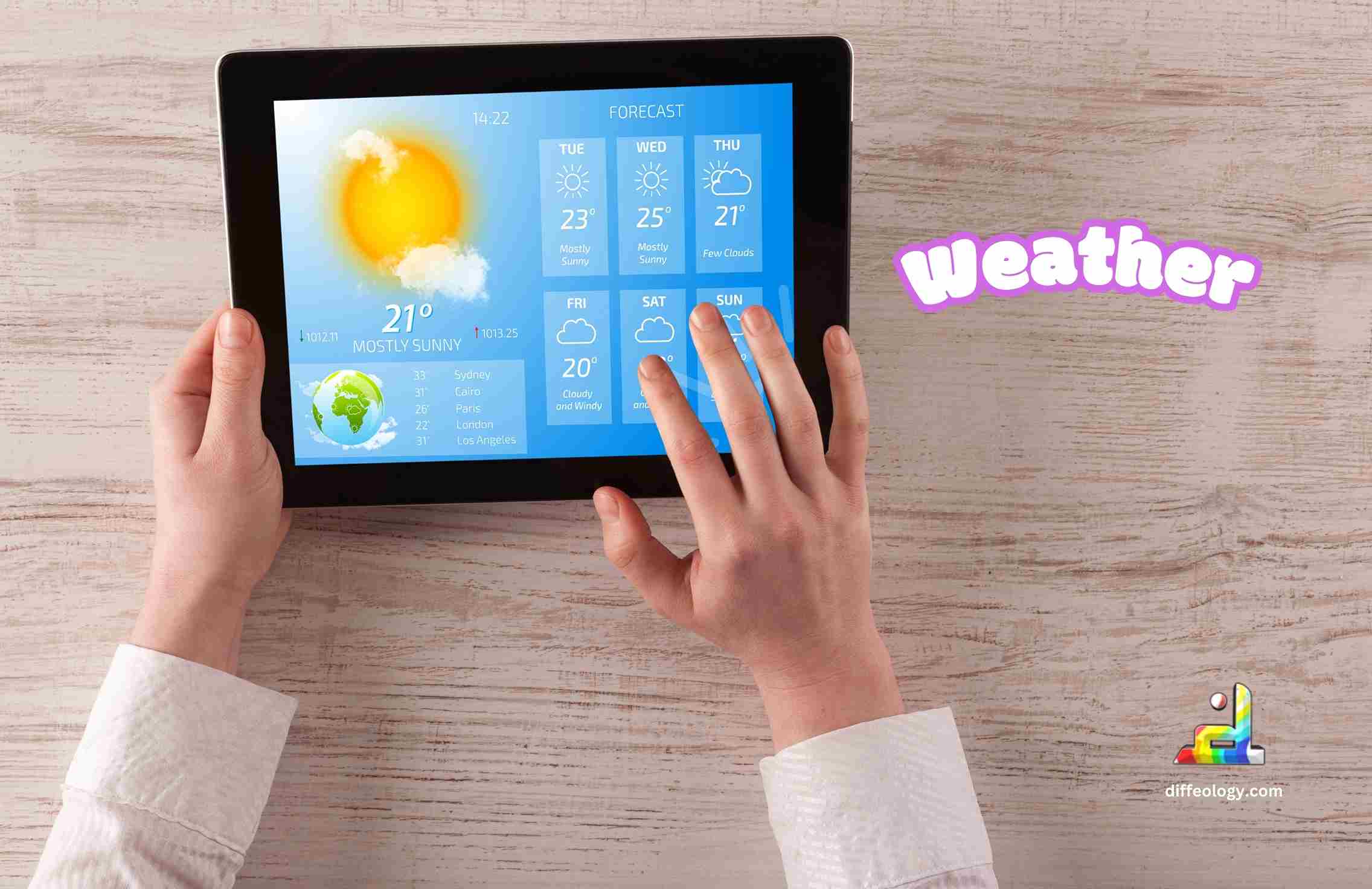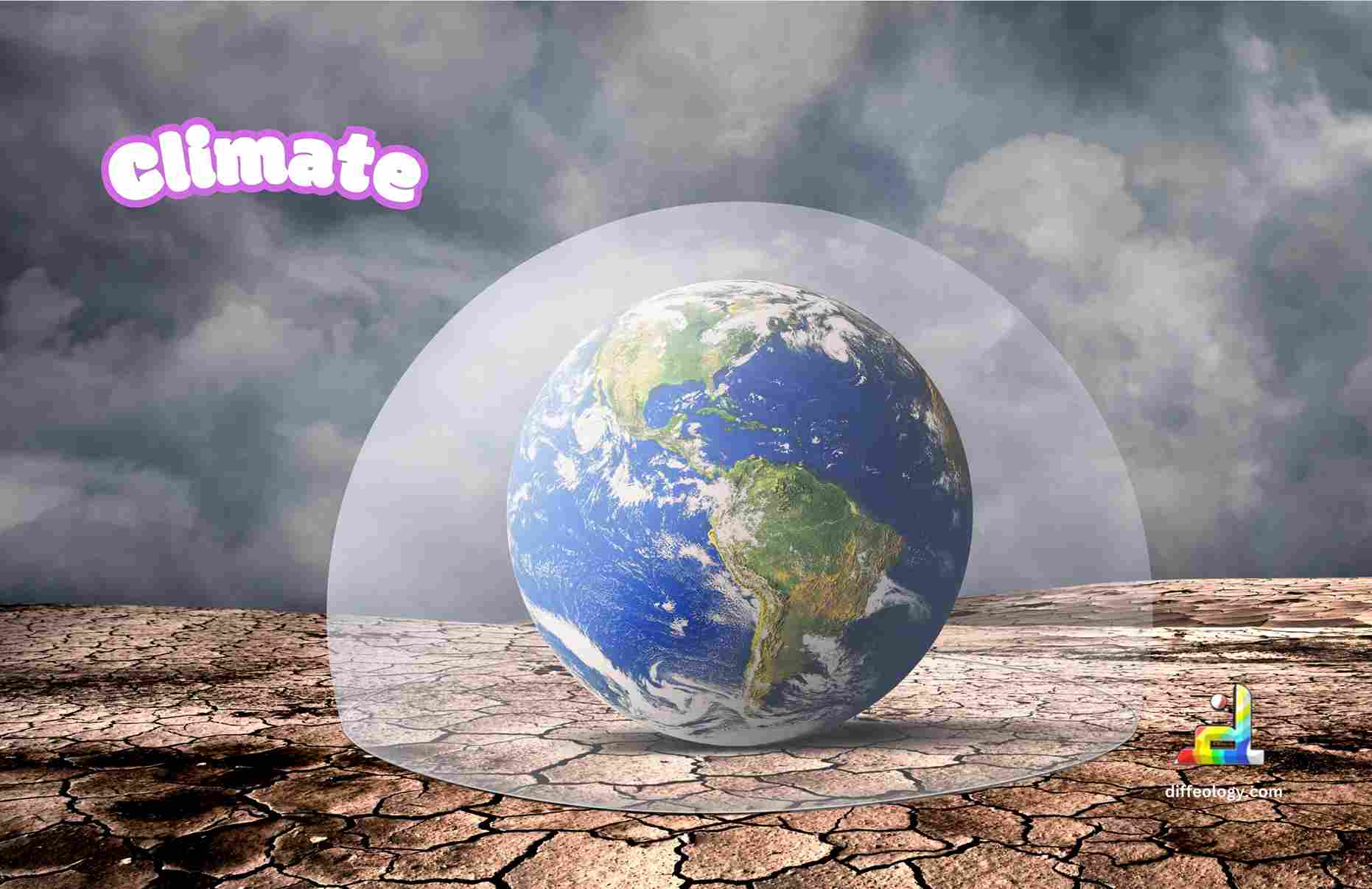Weather and climate are two important aspects of our environment that affect our daily lives. Weather refers to the day-to-day changes we experience in the atmosphere, such as rain, wind, temperature, and cloud cover. It’s what we see and feel outside on any given day. Climate, on the other hand, is the long-term pattern of weather in a specific area. It’s what we expect the weather to be like over a longer period, like seasons or even years. Understanding the difference between weather and climate helps us predict what kind of conditions we might encounter and how they might change over time.
Main Difference Between Weather and Climate
Weather conditions can change rapidly, requiring adaptable responses. Climate trends evolve slowly, allowing for gradual adjustments and planning. Weather impacts individuals and communities on a daily basis. Climate impacts global systems, economies, and ecosystems over extended periods. Weather understanding is based on short-term observations and forecasts. Climate understanding involves analyzing historical data, trends, and complex atmospheric processes.
Weather Vs. Climate
What is Weather?
Weather refers to the atmospheric conditions in a specific place at a particular time, including factors like temperature, humidity, precipitation (rain, snow, sleet), wind speed, and cloud cover. It’s what we experience outside on a daily basis, whether it’s sunny, cloudy, rainy, or windy. For example, when it’s hot and sunny, you might want to wear shorts and a t-shirt to stay cool, while on a rainy day, you’d need an umbrella and raincoat.
Read Also: Difference Between Heat and Temperature
Weather can change quickly, sometimes within hours or minutes, and it varies from one location to another due to factors like latitude, altitude, and proximity to oceans and mountains. Weather forecasts help us predict what the weather will be like in the coming days, allowing us to plan outdoor activities, dress appropriately, and prepare for any potential hazards like storms or extreme temperatures. Understanding weather helps us make informed decisions and adapt to our ever-changing environment.
What is Climate?
Climate refers to the typical weather patterns observed in a particular region over a long period, usually at least 30 years. It includes factors like temperature, precipitation, humidity, wind patterns, and atmospheric pressure. Climate determines what kind of weather you can expect in a certain area throughout the year. For example, some places have a tropical climate, which means they’re generally warm and humid year-round, while others have a polar climate, with cold temperatures and snow.
Read Also: Difference Between Bio and Non Bio Detergent
Climate change, often linked with global warming, refers to the long-term alteration of these weather patterns due to human activities, such as burning fossil fuels and deforestation, which release greenhouse gasses into the atmosphere. These gasses trap heat, leading to rising temperatures and altering climates worldwide. Climate change impacts ecosystems, agriculture, sea levels, and extreme weather events like hurricanes and droughts, affecting people and animals globally. Understanding climate helps us predict future weather patterns and prepare for the challenges posed by climate change to protect our planet and its inhabitants.
Comparison Table “Weather Vs. Climate”
| Definition | Short-term atmospheric conditions | Long-term patterns of weather |
| Duration | Changes frequently, day to day | Changes slowly over decades |
| Scope | Localized, varies within small areas | Applies to larger regions |
| Predictability | Short-term forecasts, typically up to a week | Long-term projections based on data |
| Factors | Influenced by temperature, humidity, etc. | Influenced by latitude, altitude, etc. |
| Variability | Highly variable and unpredictable | More stable and predictable |
| Impacts | Affects daily activities and plans | Impacts ecosystems and planning |
| Observation | Measured by instruments like thermometers | Assessed through historical data |
| Response | Immediate responses to warnings | Long-term strategies and adaptation |
| Measurement | Short intervals, hours or days | Collected over decades or centuries |
| Focus | Short-term events and immediate effects | Long-term trends and underlying factors |
| Flexibility | Rapid changes, requires adaptability | Gradual changes, allows for planning |
| Impact Scale | Affects individuals and communities | Impacts global systems and economies |
| Understanding | Based on short-term observations | Analyzed through historical data |
Difference Between Weather and Climate in Detail
Nature of Variation
Weather refers to the day-to-day atmospheric conditions in a specific location, such as temperature, humidity, precipitation, and wind speed. These conditions can change rapidly, sometimes within hours or minutes. For example, you might experience sunny skies in the morning but have rain showers in the afternoon. Weather is unpredictable and can vary greatly from one place to another.
Climate, on the other hand, represents the long-term average of weather patterns in a particular region over a period of time, usually spanning decades. It encompasses factors like average temperature, precipitation levels, and prevailing winds. Climate provides a broader picture of the typical weather conditions expected in a given area. While weather can change quickly, climate changes occur over longer periods, influencing the overall weather patterns experienced in a region.
Time Scale
The time scale for weather events is short-term, typically ranging from minutes to weeks. Weather forecasts predict atmospheric conditions for specific days or even hours ahead. These forecasts help people plan daily activities and prepare for short-term weather changes, such as bringing an umbrella if rain is expected.
Climate operates on a much longer time scale, typically covering decades or even centuries. Climate data is collected over extended periods to determine average weather patterns and trends. Climate studies focus on understanding long-term changes in temperature, precipitation, and other meteorological factors. Climate data is crucial for assessing the impact of human activities on global climate change.
Spatial Coverage
Weather conditions can vary significantly from one location to another, even within a relatively small area. Microclimates, such as urban heat islands or coastal breezes, create localized weather patterns influenced by geographic features. Weather reports provide specific forecasts tailored to different regions, considering factors like elevation, proximity to water bodies, and urbanization.
Climate encompasses larger geographical regions and is characterized by broader weather patterns that persist over time. Climate zones, such as tropical, temperate, and polar regions, are defined based on long-term weather patterns and climatic conditions. Climate data helps scientists identify global climate zones and understand how they influence ecosystems, agriculture, and human settlements.
Predictability
Weather forecasting relies on sophisticated computer models and observational data to predict short-term atmospheric conditions. While modern forecasting techniques have improved accuracy, weather forecasts beyond a few days tend to be less reliable due to the inherent complexity of atmospheric dynamics. Factors like sudden weather changes or atmospheric disturbances can challenge forecast accuracy.
Climate predictions focus on long-term trends and patterns rather than specific weather events. Climate models analyze historical climate data and project future changes based on factors like greenhouse gas emissions and natural climate variability. While climate predictions have uncertainties, they provide valuable insights into potential climate scenarios and help policymakers develop strategies for climate adaptation and mitigation.
Influence on Daily Activities
Weather directly impacts our daily activities and decisions, influencing what we wear, how we travel, and what outdoor activities we can engage in. For example, a sunny day might prompt us to go for a picnic or play outdoor sports, while a snowstorm could disrupt transportation and school schedules. Weather conditions also affect industries like agriculture, construction, and tourism.
Climate indirectly influences daily activities by shaping the overall environmental conditions in a region. For instance, regions with hot and dry climates may rely on irrigation for agriculture, while areas with cold climates may require heating systems for homes and buildings. Climate also influences biodiversity, ecosystem dynamics, and natural hazards like droughts, floods, and hurricanes, which impact human societies and ecosystems.
Measurement and Monitoring
Weather conditions are measured and monitored using various meteorological instruments and observation networks. Parameters like temperature, humidity, wind speed, and precipitation are regularly recorded at weather stations worldwide. Weather satellites and radar systems provide real-time data on atmospheric conditions, enabling meteorologists to track weather systems and issue timely forecasts and warnings.
Climate data is collected through long-term monitoring of temperature, precipitation, atmospheric composition, and other climatic variables. Climate monitoring networks, such as the Global Climate Observing System (GCOS), gather data from weather stations, buoys, satellites, and other sources. Climate scientists analyze this data to assess long-term trends, variability, and changes in the Earth’s climate system.
Impacts on Society and Environment
Weather events like storms, heatwaves, and droughts can have significant impacts on society and the environment. Severe weather events can cause property damage, disrupt transportation and infrastructure, and pose risks to human health and safety. Extreme weather events are becoming more frequent and intense due to climate change, highlighting the importance of preparedness and resilience measures.
Climate change poses widespread risks and challenges to society and the environment, affecting ecosystems, economies, and human well-being. Rising temperatures, changing precipitation patterns, and sea-level rise threaten food security, water resources, and coastal communities. Climate-related hazards like heat waves, wildfires, and hurricanes exacerbate social inequalities and environmental degradation, underscoring the urgent need for global climate action.
Key Points Showing the Difference Between Weather and Climate
- Definition: Weather refers to short-term atmospheric conditions in a specific place and time, like rain or sunshine. Climate refers to long-term patterns of weather in a particular area, including temperature, humidity, and precipitation averages over several decades.
- Duration: Weather changes frequently and can vary from day to day or even hour to hour. Climate changes slowly over decades or centuries and represents the average of weather patterns over a long period.
- Scope: Weather is localized and can differ significantly within small areas. Climate applies to larger regions and is consistent over broader geographical areas.
- Predictability: Weather forecasts provide short-term predictions, typically up to a week in advance. Climate models project long-term trends based on historical data and scientific understanding.
- Factors: Weather is influenced by factors like temperature, humidity, air pressure, and wind. Climate is influenced by larger-scale factors such as latitude, altitude, ocean currents, and land features.
- Variability: Weather can be highly variable and unpredictable due to rapid changes in atmospheric conditions. Climate variability is more stable and predictable, with gradual changes over longer periods.
- Impacts: Weather impacts daily activities, like clothing choice and outdoor plans. Climate impacts ecosystems, agriculture, and human settlements over long-term planning and adaptation.
- Observation: Weather is observed through instruments like thermometers, barometers, and satellites. Climate is assessed through historical weather data, climate models, and proxies.
- Response: Weather warnings prompt immediate responses, such as preparing for storms or extreme temperatures. Climate change requires long-term strategies, including reducing greenhouse gas emissions and adapting to changing conditions.
- Measurement: Weather parameters are measured in short intervals, like hours or days. Climate data are collected over decades or centuries to establish long-term trends.
- Focus: Weather focuses on short-term atmospheric events and their immediate effects. Climate focuses on long-term trends and the underlying factors driving those patterns.
FAQs: Weather Vs. Climate
Conclusion:
While weather and climate are related, they are distinct concepts with different focuses and time scales. Weather deals with short-term atmospheric conditions that can change rapidly, affecting our daily activities and immediate surroundings. Climate, on the other hand, refers to the long-term average of these weather patterns over a much longer period, providing a broader understanding of the overall atmospheric conditions in a particular region. By knowing the Difference Between Weather and Climate, we can better comprehend the complexities of our environment and make informed decisions to adapt and mitigate the impacts of changing weather and climate patterns.
References & External Links
- Local, National, & Global Daily Weather Forecast
- Climate Forecast System (CFS)



